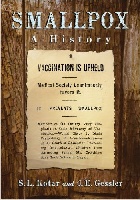Smallpox A History

by S.L. Kotar and J.E. Gessler
Published by: McFarland Publishing
Buy it now on AMAZON
Preface
A paragraph in a local 19th century newspaper presented an interesting scenario under the heading of “Burial of Small-Pox”:
Funeral Notice: Died at Sierra City, California, February 22, 1888, Small-Pox. As the deceased has no friends in town, his enemies are invited to assemble at Spencer & Moore’s hall at 8 o’clock, to dance on his coffin. The funeral exercises will be under the auspices of the Butte’s Band, which will pipe its level best for the occasion. Tickets, $1. P.S. – The wake will continue ad libitum at the close of the dance.
The notice indicated that a scourge of smallpox had just succeeded in being stamped out. With the quarantine lifted, virtually the entire town turned out to celebrate, including 35 persons who had recovered fro the disease. The dance program included, the “Small-pox Polka,” the “Virus Jig,” the “Vaccination Reel,” and the “Quarantine Quadrille.”
While the article was meant to be amusing, smallpox was no laughing matter. Although its origins are obscure, the speckled disease seemingly plagued mankind for “time immemorial,” leaving staggering death rates, fortifying scars and blindness in its wake.
Few, if any, persons living in the 21st century have ever seen a case of variola major or variola minor as the two strains of the disease are more specifically designated. Combating it began almost as soon as it appeared among our ancient ancestors. Most early treatments relied upon superstition and pseudoscience, but long before smallpox became a international scourge brilliant minds developed surprisingly effective methods for preventing, if not curing the disease. These methods of inoculation never became widespread, and over the course of centuries smallpox was spread from its relatively small containment throughout the glove. Religious travelers to and from Mecca, Crusaders, slave traders, merchants and explorers all played a part in importing it throughout Africa, the Middle East, India and finally to Europe and the New World. Statistical evidence of early smallpox is nearly impossible to obtain and accounts of the disease come from vague, firsthand accounts. It was not until Europeans began colonizing distant lands that identification, containment, treatment, “cures” and records assumed paramount importance.
Smallpox was known as a disease that spared neither commoner nor royalty, and the dread of it became so great that children were not considered part of the family until they had successfully contracted and passed through the contagion. Thereafter they were immune from further attacks and safe to be included.
Inoculation, or the passage of live smallpox virus from one person to another, either by inhaling dried crusts of through implantation into the skin, provided immunity but made the recipient a carrier, capable of infecting healthy persons. Often decried by religious practitioners as an offensive against God under the belief that smallpox existed as a punishment to humans an ought to be accepted as such, scientists pursued inoculation as the only means at their disposal to prevent epidemics and high death totals.
Edward Jenner, who became known as the Father of Immunology, developed the method of “vaccination” in 1798 by extracting matter from cows suffering from the related disease, cowpox, and inserting it under the skin of healthy individuals to initiate a mild disease similar to but not exactly the smallpox. When the person recovered, immunity from variola was achieved. This technique eliminated the threat of carriers, thereby providing a preventive for the deadly disease.
While it would appear that Jenner’s brilliant discovery, carried across the globe, would all but eliminate smallpox as a threat, condemnation of his idea was fast and furious. Nineteenth century authorities from scientists to clerics debunked the operation , crying out that people would become beasts from having animal matter inserted into their bodies or that, as God had created smallpox, humans ought to suffer from it without complaint. This group, who would later become known as anti-vaccinationists, were so successful that smallpox continued to be a scourge, nearly devastating entire populations, including the indigenous populations of North America. As hard as it is to believe, debate against vaccination carried over well into the 20th century and it was not until a massive global effort, years after man had walked on the moon, that the World Health Organization declared smallpox eradicated.
This book details the history of smallpox, its spread, mutations and deadly effects. More important, however, it was our intent to chronicle the medical, political and moral considerations of combating the Speckled Disease through the words of those directly involved in the struggle. Contemporary accounts of those who faced the daily threat of death: those who researched the virus, performed the operations, compiled the data (occasionally speculative in nature), penned the editorials and saw loved ones suffer the untold agonies of the disease are the real story. Conquering smallpox took inestimable courage, insight, inspiration and a dedication almost beyond belief. The achievements of these people, their world brethren into heights farther than the stars, are staggering. It is therefore up to us, and the generations that follow, to acknowledge our deep gratitude for what the achieved and what they sacrificed.